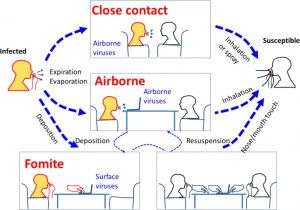The Emergence of Epidemic Process
For the infectious process, three main conditions are needed to develop the epidemic process:
1) the source of infection,
2) the mechanisms (routes) of the disease transmission,
3) susceptible population affected by the causative agent.
- The origin of infection is the place of actual habitation of the causative agent, its propagation and removal into the environment.
- Alive microorganisms are the major sources of infection (sick humans or animals and microbial carriers).
- The deposition of infection protect the pathogen in the environment but usually, the infectious agent cannot propagate in the reservoir.
- There is a huge complex of several mechanisms (or routes) of transmission of infectious diseases. These are:
- faecal-oral route that involves alimentary (food-borne),
- water-borne, contact (via fomites) and other possible routes;
- air-borne route (e.g., air-droplet or dust disease transmission);
- vector-borne route associated with different vectors – insects, arthropods, etc.
- Connection route with the disease transmission by sexual intercourse or by direct contact;
- Un-natural route based predominantly on disease transmission by medical manipulations (iatrogenic route);
- vertical transmission (from mother to fetus).

- Multiple auxiliary vehicles provide support to certain routes of transmission of infection. For instance, the faecal-oral route can be realized via, the dirty hands, absorbing pathogenic bacteria, or by flies, carrying infectious agents.
- Various objects, surfaces or substances contaminated with microorganisms could carry the pathogens from one susceptible person to another.
- The air-borne route is associated with air and dust flows, air conditioning state, etc.
- According to the main localization of the causative agent, all infections are divided into
- intestinal (affecting the gastrointestinal tract with faecal-oral transmission).
- respiratory (of the respiratory tract); blood infections (with primary localization of pathogen in the blood due mainly to vector-borne disease transmission or by artificial route).
- infections of integument tissues (causative agents are localized on the skin or mucosal tissues), “vertical” infections with disease transmission from mother to fetus.
- According to specific habitation of the causative agents, infectious diseases are classified as anthroponoses, zoonoses and prognoses.
- If a pathogen infects only humans, the disease type is anthroponosis. The disease, caused to animals, is regarded as a zoonosis.
- The causative agents of zoonoses can also affect humans resulting in zooanthroponoses.
- And the last group comprises the number of diseases with the substantial role of the external environment in their spread (so-called prognoses).
- For example, anthrax spores stay viable in the soil for several years before infecting.
- This is true for most of the sporogenic bacteria. Water is the environment of vibrio cholera habitation, as well as for leptospirosis agent.
- In general, disease distribution within some population varies strongly, depending on infectious agent nature and population susceptibility.
- Infectious diseases may be sporadic (separate cases of the disease, registered in some area during a certain period of time).
- Usually sporadic reflects an ordinary level of morbidity.
- The great rise of incidence of a certain disease that affects the large territories is known as an epidemic (or epizootic in animals).
- Disease outbreak is “a small epidemic” – restricted by time and area sharp raise of the disease, where individual disease cases are closely related.
- And when the epidemic covers unusually large territories or spreads over many countries or even continents, it is called a pandemic.
- A special form of infectious diseases spread is known as endemic.
- Endemic is referred to as the disease retaining in some locality for a long period of time.
- Sometimes it can be restricted by vector habitat, or by the geographical barriers. Nevertheless, the endemic is an effective threat of massive disease outbreak due to developed people communications – travelling, air flights, etc.
REFERENCES
- https://wwwnc.cdc.gov/eid/article/1/1/95-0102_article
- https://www.who.int/emergencies/diseases/managing-epidemics-interactive.pdf
